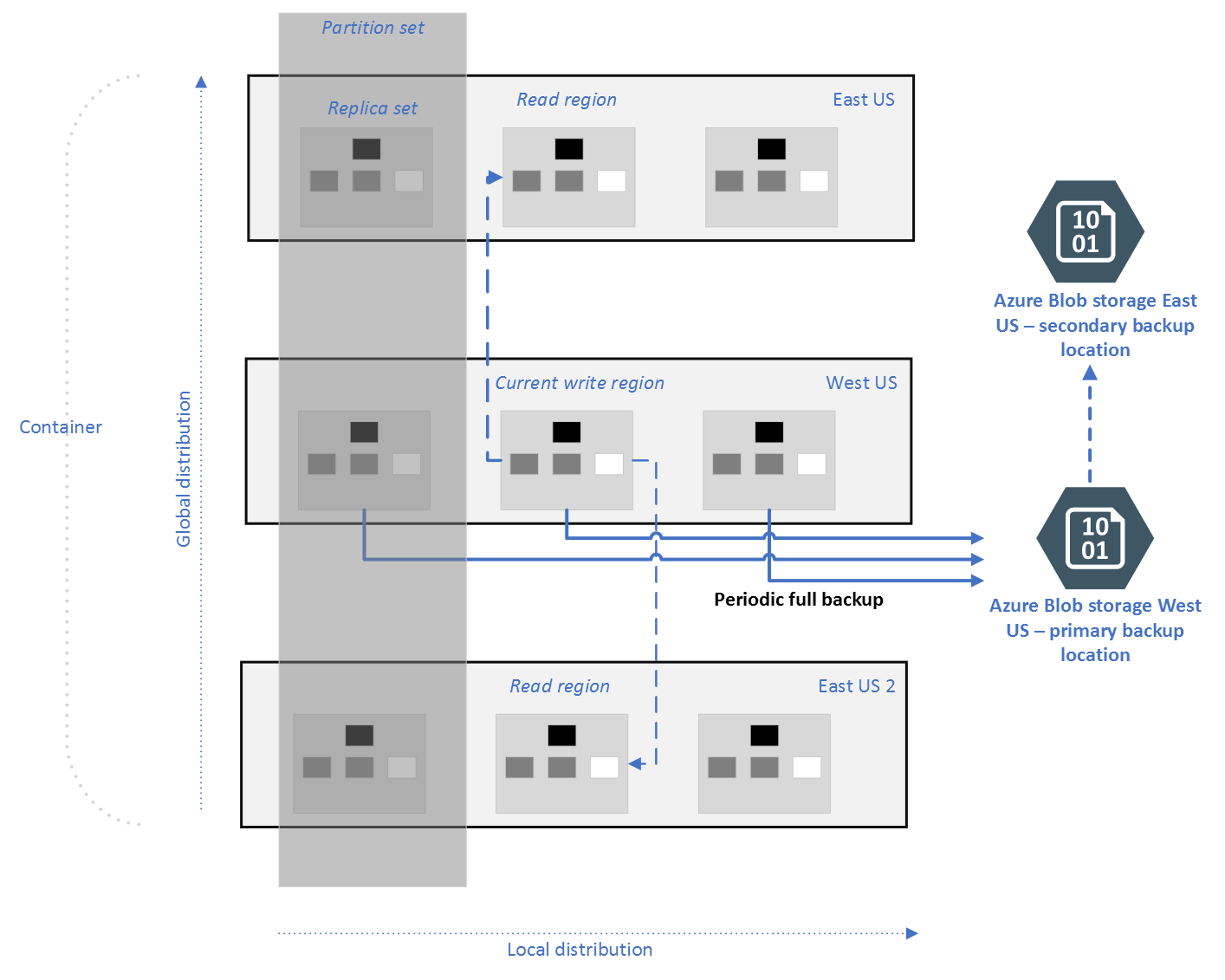Periodic backup and restore in Azure Cosmos DB
APPLIES TO:
NoSQL
MongoDB
Cassandra
Gremlin
Table
Azure Cosmos DB automatically takes backups of your data at regular intervals. The automatic backups are taken without affecting the performance or availability of the database operations. All the backups are stored separately in a storage service, and those backups are globally replicated for resiliency against regional disasters. With Azure Cosmos DB, not only your data, but also the backups of your data are highly redundant and resilient to regional disasters.
How Azure Cosmos DB performs data backup
The following steps show how Azure Cosmos DB performs data backup:
Azure Cosmos DB automatically takes a full backup of your database every 4 hours and at any point of time, only the latest two backups are stored by default. If the default intervals aren't sufficient for your workloads, you can change the backup interval and the retention period from the Azure portal. You can change the backup configuration during or after the Azure Cosmos DB account is created. If the container or database is deleted, Azure Cosmos DB retains the existing snapshots of a given provisioned throughput container or shared throughput database for 30 days. If throughput is provisioned at the database level, the backup and restore process happens across the entire database scope.
Azure Cosmos DB stores these backups in Azure Blob storage whereas the actual data resides locally within Azure Cosmos DB.
To guarantee low latency, the snapshot of your backup is stored in Azure Blob storage in the same region as the current write region (or one of the write regions, in case you have a multi-region write configuration). For resiliency against regional disaster, each snapshot of the backup data in Azure Blob storage is again replicated to another region through geo-redundant storage (GRS). The region to which the backup is replicated is based on your source region and the regional pair associated with the source region. To learn more, see the list of geo-redundant pairs of Azure regions article. You can't access this backup directly. Azure Cosmos DB team restores your backup when you request through a support request.
The following image shows how an Azure Cosmos DB container with all the three primary physical partitions in West US. The container is backed up in a remote Azure Blob Storage account in West US and then replicated to East US:
The backups are taken without affecting the performance or availability of your application. Azure Cosmos DB performs data backup in the background without consuming any extra provisioned throughput (RUs) or affecting the performance and availability of your database.
With the periodic backup mode, the backups are taken only in the write region of your Azure Cosmos DB account. The restore action always restores data into a new account which is located in the write region of the source account.
What is restored into new account?
- You can choose to restore any combination of provisioned throughput containers, shared throughput database, or the entire account.
- The restore action restores all data and its index properties into a new account.
- The duration of restore will depend on the amount of data that needs to be restored.
- The newly restored database account’s consistency setting will be same as the source database account’s consistency settings.
What isn't restored?
The following configurations aren't restored after the point-in-time recovery.
- A subset of containers under a shared throughput database cannot be restored. The entire database can be restored as a whole.
- Database account keys. The restored account will be generated with new database account keys.
- Firewall, VNET, Data plane RBAC or private endpoint settings.
- Regions. The restored account will only be a single region account, which is the write region of the source account.
- Stored procedures, triggers, UDFs.
- Role-based access control assignments. These will need to be re-assigned.
- Documents that were deleted because of expired TTL.
- Analytical data when synapse link is enabled.
- Materialized views
Some of these configurations can be added to the restored account after the restore is completed.
Azure Cosmos DB Backup with Azure Synapse Link
For Azure Synapse Link enabled accounts, analytical store data isn't included in the backups and restores. When Azure Synapse Link is enabled, Azure Cosmos DB continues to automatically take backups of your data in the transactional store at a scheduled backup interval. Automatic backup and restore of your data in the analytical store isn't supported at this time.
Understanding the cost of backups
Two backups are provided free and extra backups are charged according to the region-based pricing for backup storage described in backup storage pricing.
For example, consider a scenario where Backup Retention is configured to 240 hrs (or 10 days) and Backup Interval is configured to 24 hours. This configuration implies that there are 10 copies of the backup data. If you have 1 TB of data in an Azure West US region, the cost for backup storage in a given month would be: 0.12 * 1000 * 8
Required permissions to manage retention or restoration
Principals who are part of the role CosmosdbBackupOperator, owner, or contributor are allowed to request a restore or change the retention period.
Manually managing periodic backups in Azure Cosmos DB
With Azure Cosmos DB API for NoSQL accounts, you can also maintain your own backups by using one of the following approaches:
Azure Data Factory
Use Azure Data Factory to move data periodically to a storage solution of your choice.
Azure Cosmos DB change feed
Use Azure Cosmos DB change feed to read data periodically for full backups or for incremental changes, and store it in your own storage.
